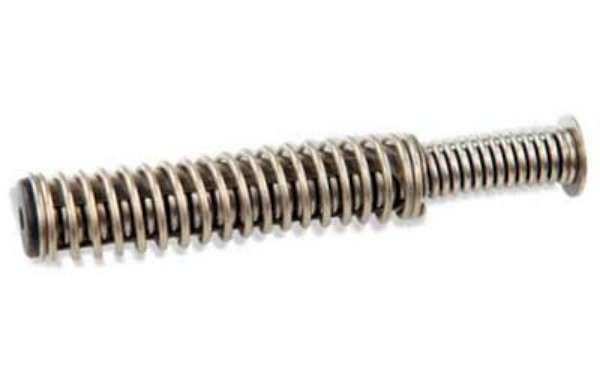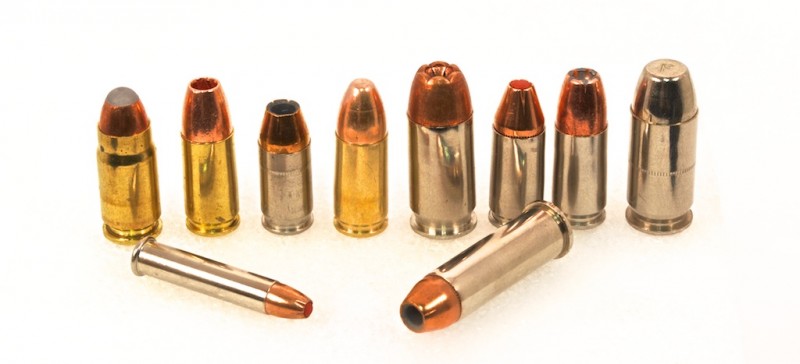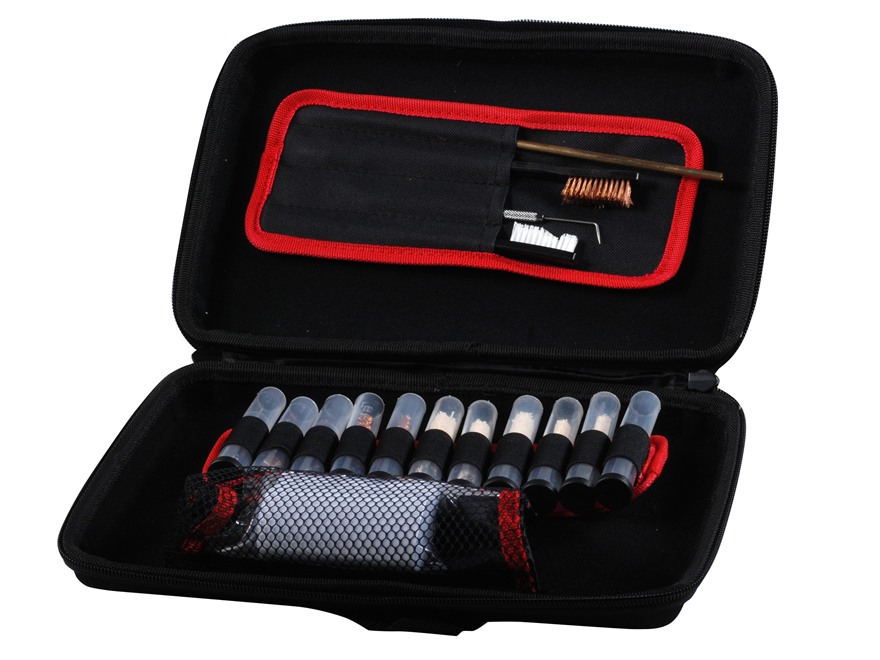Table of Contents
Now that you’ve learned all there is to know from our Glock 19 gen 4 review, let’s focus our attention on another favorite of mine. I don’t always spend lots of time at the range, but when I do I have my Glock 17 with me. It is my carrying gun. The Glock 19 remains in a safe at home, but I usually train with the 17.
The Glock 17 is one of the most widely-used handguns in the world, and it continues to be the weapon of choice for first-timers as well as veteran shooters. Professionals are also very fond of the Glock, and it can be seen competing in a wide range of events all over the world.
The Man Who Started It All: Gaston Glock
Glock KG was founded in 1963 by an engineer named Gaston Glock. The company, based in Austria, produced steel and plastic parts. In the 70’s, Glock began producing knives, training grenades, and other products for the Austrian military.
The connections Glock formed with the military led to new opportunities. In 1980, Glock KG received a formal invitation from the Austrian military to develop a new service sidearm. The army wanted to replace their older WWII models, and wanted the company to be involved.
Gaston Glock did not have any firearm experience whatsoever, but he nevertheless accepted the invitation, and set out to create a new handgun for the Austrian military.
Glock put together a team in order to pinpoint traits and qualities which would make up the perfect gun. A few months later, Glock had developed a prototype. The company submitted the semi-automatic model no. 17, so named because it was Glock’s 17th patent, to the approval and scrutiny of the Ministry’s various committees. The tests which the competing guns underwent were harsh and very demanding. Eventually, the Austrian Ministry of Defense decided to pick up Glock’s option, and the model 17 became Austria’s service handgun. The Glock came in first, beating local and international companies who were also competing for the contract.
Austrian military and police began carrying Glock 17 firearms in 1982, and following that the brand had expanded worldwide. Soon after the Glock made its appearance, the Norwegian and Swedish armed forces began carrying it as well. The Glock 17’s popularity grew, and in 1984 NATO took it in as well, making it a standard firearm and giving it a NATO stock number.
Glock’s main offices are in Austria, but they also have offices in the United States, Uruguay, Hong Kong, and the United Arab Emirates.
Glock Generations
Over the years, the Glock 17 went through different releases. These were nicknamed “generations” by Glock users, and the name stuck. The company itself has since adopted the term as well, and released its latest Glock 17 as “Gen 4”.
A short timeline:
1982 – Glock produces the Glock model number 17. It has smooth grips on the front and back straps. There is texture on the handle. This is the basis of the Glock, which has remained pretty constant. This is the model known as Gen 1.
1988 – The Gen 2 is produced. One major change is that the recoil spring is one piece, as opposed to the spring on the Gen 1. The grip is also different, since Glock added checkering to the front and back panels.
1996 – The Gen 3 comes along, and it sports some very visible changes – accessory rail, finger grooves, and thumb rest, to name a few. In my opinion, the Gen 3 is a very comfortable gun to hold. Internally, the Glock 17’s mechanism has a few differences, too. There is a smaller magazine-release button, but after training with it, it becomes a very natural gun to work with. This is my personal favorite, which is why it is the one that I carry.
2010 – Gen 4 is released, with the company actually writing Gen 4 on the gun’s slide. The parts of earlier Glock 17 models (Gen 1, 2 and 3) were completely interchangeable, but that is not the case with the Gen 4. Only some of the Glock 17 Gen 4’s parts are interchangeable.
Two main things were different about the Gen 4:
First, ergonomics. Second, the recoil system.
Ergonomically, the Gen 4 was a step up. First off, Glock provides multiple, interchangeable back straps along with the gun. Second, the company reduced the gun’s grip. Third, there is a larger magazine release button. The larger magazine release means that a shooter doesn’t need to change the grip in order to change magazines, and that is a huge advantage. Furthermore, the button can be switched from left to right. This ambidextrous design accommodates different shooters.
The magazine release button also caused the magazines themselves to be different, and with the Gen 4 the magazines have an extra cutout, which make them ambidextrous as well. A shooter can still opt to use older Gen magazines. The Gen 4 magazines will fit any older generation, so there is no problem there.
These ergonomic differences allow the Glock 17 to fit many different types of hands. The texturing on the gun also changed with the Gen 4’s release, and it took on a different look and feel. It wasn’t the first time that a textured handle was introduced, but unlike the Gen 2 and Gen 3’s sandpaper-like surface or pyramid-looking grips, the Gen 4 has a smoother texturing.
This smoother texturing can be found on the back straps and also in the finger grooves. There is also some special texturing on the front of the trigger guard.
The Gen 4 grips are much better than the Gen 3, and this was a smart move on Glock’s part. It shows just how attentive they are to their customers, and that is no small thing. Ultimately, it is what makes any business work.
As for the recoil system: Gen 4 pistols were equipped with dual recoil springs. In September 2011, Glock initiated a spring exchange program at no extra cost to the customer. According to Glock, the company did this in order to ensure that the Gen 4 was up to standards. In other words, there was a kind of recall. The dual recoil spring was meant to help with recoil, and to improve the life of the gun. The dual recoil springs mean that there is less recoil, and that the muzzle climb is also lessened. This contributes to faster target acquisition, and in a crunch this could mean the difference between life and death.
Dual recoils are also available for the previous Gens, but they became standard with the Gen 4. The dual recoil spring system meant that the Gen 4 came with some changes to the rail system and the frame. Even before the dual recoil spring was used with the Glock 17, Glock was using it with its subcompact handguns, like the Glock 26 and 36.
Gun Safety
As for the Glock’s safety, this has been one of the gun’s advantages from the beginning. The Glock 17 has three safety mechanisms, and they are all related to the trigger. This is why the Glock was introduced as a “safe action” pistol. Two safety features are internal, and one is external.
First, there is an external trigger safety. The trigger safety prevents inadvertent firing, and – once the trigger has been pulled – releasing it automatically reactivates the safety.
Second, the Glock has an internal firing pin safety. Glock 17 is striker-fired, and the pin safety prevents accidental discharges.
Third, there is an internal drop safety feature. Part of the tests which the guns undergo have to do with dropping them from various heights. The guns are repeatedly dropped, to test their reliability.
Glock is simplicity. “Less is more” is a rule of thumb which can be applied in many situations. Firearms are no different. The more parts there are, the more there is that may go wrong with the gun. The Glock 17 has only 35 parts, and that means that it is easy to take apart and easy to reassemble. A field stripping will take seconds (after some training), and that is saying a lot. Furthermore, because there are not many pieces to handle, Glock parts can be switched and modified with greater ease.
The Glock 17 has only two external functions – the slide release and the magazine release. That’s it. Simple. And I happen to love that about this gun. Later generation Glock 17’s are treated with tenifer on the slide, and so they are very resistant to scratches, corrosion, and wear.
Parts and Treatments
Many of the Glock’s parts are made of high strength polymer based on nylon. The rest of the gun is made of steel. The polymer (called polymer-2) in the gun is an invention of Gaston Glock himself. The substance was very unconventional when it was first introduced. Over time, it became clear that Glock knew what he was doing when the company released this new and revolutionary handgun.
Polymer-2 is a substance which is, first and foremost, resistant. It is more resilient than many different steel alloys. This substance can withstand very hot temperatures, shock, and different liquids.
The Glock’s slide is made of a single block of steel, which is made using advanced CNC technology. The barrel and slide are hardened twice, to make sure that they are of the best quality. After that, the slide and barrel are subjected to a tenifer treatment. Tenifer is a substance that is also extremely resistant, and it is a standard in the weapons industry. After the treatment is complete, the gun has a matte gray kind of look to its surface, and that is when a Parkerized finish is applied to the handgun, to give it its final look.
The tenifer treatment helps to protect the steel parts which are inside. What that means is that even if the finish were to wear off, the tenifer-treated parts would still be protected. Tenifer is even effective up to a certain depth below the surface, so you can technically (and practically, for that matter) fire this weapon under water.
Ammo
Okay, let’s talk ammo. Full metal jacket or hollow point cartridges are okay, but Glock itself recommends that owners do not use reloaded ammo in the Glock’s barrels. Reloaded ammo is treated differently, and only certain barrels can withstand its power. In truth, the barrel of a Glock 17 could most likely take any kind of 9mm ammo and continue firing. However, it is best to adhere to the company’s suggestions. After all, they are the ones who made the gun.
And as long as we are discussing ammo, let’s bring the magazine into the picture. The Glock 17 Gen 4 comes with 3 factory-made, 17-round polymer magazines. The other Gens come with 2 magazines in their case.
Let’s look at a few more features:
Firepower – the ability to insert 17-, 19-, and even 33-round magazines into this firearm’s magazine slot is fantastic. Whether you are concealed carrying, are in active duty, or simply at the range, you will be able to find a magazine that you are comfortable with.
Accuracy – even with 33 rounds in a magazine and 1 in the chamber, the gun isn’t worth much without its accuracy. Being on target is ultimately the purpose of every round which leaves the barrel of any gun. The Glock 17 (and its extended family) are all extremely accurate. Point and shoot. Again, simple.
Durability – when it first came out, the question of durability was a big one. People were calling it a plastic pistol, and there was talk of the gun not being durable due to the elements which it was made of. After more than 30 years, the Glock’s durability cannot be contested or denied. It is very durable, and it can withstand harsh conditions. Heat, cold, mud, sand, countless rounds. The Glock can take it all and keep on firing.
Ergonomics – this was covered a little earlier, but let’s expand on it. Like every weapon, the Glock 17 is polarizing. Some love the way it feels in their hand, and some hate it. It is impossible to find a shape or size that is universally loved by all. I didn’t fall in love with the Glock 17 Gen 4 on sight, for instance. I worked on it, broke it in, and trained with it. What I found is that once you get used to the feel of a Glock 17, you discover that it is a wonderful fit. If you have a Gen 4, feel free to experiment. If you have a different Gen, and still want to get a different look or feel to your grip, you can accessorize with aftermarket products.
Regardless, ergonomics are very important. As is training with your weapon. The grip and feel can be the most ergonomic thing ever, but unless you train, you may not be able to act when the time comes.
Sights – the factory-made sights are excellent, and even though some Glock owners choose to get other sights, they remain functional and very usable. The 3-dot configuration makes it easy to find your target and take a shot. Many companies make Glock sights, fit for day/night, made of tritium or other substances. (Learn more about tritium and other glock 19 sights here). Which brings us to…
Accessories – the Glock is easily accessorized, and there are many companies which manufacture Glock components. The Glock company itself makes a lot of accessories for its handguns. Glocks are so popular that any random gun shop will probably hold everything you need for your weapon.
Popular accessories include different slide release levers, different magazine release levers, grip additions, trigger additions, sights, barrels, lights, lasers, magazine extensions, and even custom slide covers. Many of these are also available as glock 19 accessories, most notably in the form of grip plugs, extended magazine release levers, and customizable slide covers.
Reliability – Glock handguns are all very reliable. While being engineered and manufactured, they undergo extreme tests. Glock has recalled guns several times in the past, but only one of those times included the model 17. It was and is one of the most reliable 9mm guns out there.
Price – The price of a Glock 17 will run about $500. A reasonable price, most would agree. It isn’t a super cheap gun, nor should it be. There is a reason why this is one of the most popular firearms in the world, and it isn’t because it is cheap. For the price you pay, you get great value. You get the confidence, the security, and the peace of mind that a Glock provides.
The popularity of Glock handguns means that there are a lot of companies manufacturing accessories for them. This promotes healthy competition, which yields better prices and affordability across the board.
The Glock has been around for over 30 years, and it is still considered the gun of choice for many professional and non-professional shooters, everyday carriers, as well as military, police, and government agencies around the world. It is an amazing feat of engineering, and it has proven itself time and again. The original Glock 17 is an excellent weapon, and it ranks right up there with the best of them.
Some say that the Glock 17 gen 1 should no longer be considered a weapon, and that it is an antique. I suppose it is a matter of opinion. As far as I am concerned, if you have a Glock 17 Gen 1 which you maintain and train with regularly, it is a very viable carrying option.
Some Stats and Info:
Gun length 8.03 inches
Gun height 5.43 inches
Gun width 1.18 inches
Barrel length 4.48 inches
Barrel height 1.26 inches
Length between sights 6.49 inches
Weight – at 25.5 ounces (unloaded), the Glock is lighter than many other guns in the semi-auto 9mm caliber category. This lightness it has caused it to be the butt of many jokes, but Glock is the one who is having the last laugh. Loaded, the weight of the gun is 32.12 ounces.
65% of all U.S. Law Enforcement Agencies use the Glock.
Nearly 10 million Glock handguns have been sold, and Glock remains as popular today as it ever has been. People love using these firearms, and the model 17 remains the ‘go to’ gun for countless individuals.
The Glock 17 has been approved for use by many law enforcement agencies and military units around the world. Special Forces, Police Commandos, and even the United States Marshals Service use the Glock 17.
Upgrades (recalls)
Glock has issued upgrades to its various models. It invited carriers of certain guns and makes to send their handgun in for upgrading. Rather than call it a recall, it was dubbed an upgrade. A smart move, no doubt, but the fact is that Glock was forced to upgrade its pistols from time to time, because the weapons in question had failed certain tests, and were deemed temporarily unsafe.
1992:
The infamous “six part upgrade”, which included:
Extractor
Spring-loaded bearing
Firing pin safety and spring
Firing pin / striker
Trigger bar
2011:
Recoil spring exchange program. As mentioned earlier, this was a recall which included all Gen 4’s. This upgrade wasn’t issued until the company got numerous complaints about the gun. Once the exchange was made, consumers reported that the problems were fixed.
In a press release, Glock announced that it “has developed a new design to the recoil spring assemblies (RSA) on its Gen4 pistols to replace several variations that are functioning in the market today. As part of the company’s commitment to perfection, we are voluntarily exchanging the existing RSA in order to ensure our products perform up to GLOCK’s stringent standards.”
Other upgrades were made over the years, but the 17 was not affected. The only major upgrade was the 2011 one.
Cleaning and Maintenance
In order for an individual to feel confident in his gun, it needs to be checked and maintained regularly. Cleaning is necessary for ensuring the weapon is functioning properly.
To clean your Glock, you will need to field strip it, and then use a gun-cleaning kit to hit all of the different points where dirt and grime may accumulate. Basically, this means polishing the barrel inside and out, cleaning the slide, and brushing the frame and all of its rails. A brass brush is recommended, rather than a steel one. Brass won’t do any damage to your barrel, while steel may potentially cause some damage over time.
Having a clean gun means less malfunctions. In fact, a well-cleaned Glock 17 means zero malfunctions. If you take good care of your gun, you will have faster operation speed, very few jams, and a better shooting experience. Once you are done with the cleaning, it is time to apply some lube to sensitive areas of your Glock. Use only several drops of lube for the slide, a couple for the barrel, and one drop for the frame.
When I say “sensitive areas of your Glock”, I mean the places where there is most contact. These are the areas you will want to lube up, so that the constant contact won’t become a jam when that next round is being fired. You can – should? – use your finger for this particular job, and not a rag. Unlike a cotton rag, your finger will not soak up the oil.







No comments yet.